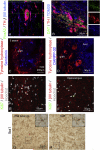Successful function of autologous iPSC-derived dopamine neurons following transplantation in a non-human primate model of Parkinson's disease
- PMID: 25732245
- PMCID: PMC4462124
- DOI: 10.1016/j.stem.2015.01.018
Successful function of autologous iPSC-derived dopamine neurons following transplantation in a non-human primate model of Parkinson's disease
Abstract
Autologous transplantation of patient-specific induced pluripotent stem cell (iPSC)-derived neurons is a potential clinical approach for treatment of neurological disease. Preclinical demonstration of long-term efficacy, feasibility, and safety of iPSC-derived dopamine neurons in non-human primate models will be an important step in clinical development of cell therapy. Here, we analyzed cynomolgus monkey (CM) iPSC-derived midbrain dopamine neurons for up to 2 years following autologous transplantation in a Parkinson's disease (PD) model. In one animal, with the most successful protocol, we found that unilateral engraftment of CM-iPSCs could provide a gradual onset of functional motor improvement contralateral to the side of dopamine neuron transplantation, and increased motor activity, without a need for immunosuppression. Postmortem analyses demonstrated robust survival of midbrain-like dopaminergic neurons and extensive outgrowth into the transplanted putamen. Our proof of concept findings support further development of autologous iPSC-derived cell transplantation for treatment of PD.
Copyright © 2015 Elsevier Inc. All rights reserved.
Figures


Comment in
-
Autologous iPSC-derived dopamine neuron grafts show considerable promise in a nonhuman primate model of Parkinson's disease.Mov Disord. 2015 Jul;30(8):1034. doi: 10.1002/mds.26267. Epub 2015 Jun 11. Mov Disord. 2015. PMID: 26095814 No abstract available.
References
-
- Barker RA, Barrett J, Mason SL, Bjorklund A. Fetal dopaminergic transplantation trials and the future of neural grafting in Parkinson's disease. Lancet Neurol. 2013;12:84–91. - PubMed
-
- Brownell A-L, Jenkins BG, Elmaleh DR, Deacon TW, Spealman RD, Isacson O. Combined PET/MRS studies of the brain reveal dynamic and long-term physiological changes in a Parkinson's disease primate model. Nature Med. 1998a;4:1308–1312. - PubMed
-
- Brownell AL, Livni E, Galpern W, Isacson O. In vivo PET imaging in rat of dopamine terminals reveals functional neural transplants. Ann Neurol. 1998b;43:387–390. - PubMed
-
- Cooper O, Hargus G, Deleidi M, Blak A, Osborn T, Marlow E, Lee K, Levy A, Perez-Torres E, Yow A, et al. Differentiation of human ES and Parkinson's disease iPS cells into ventral midbrain dopaminergic neurons requires a high activity form of SHH, FGF8a and specific regionalization by retinoic acid. Mol Cell Neurosci. 2010;45:258–266. - PMC - PubMed
Publication types
MeSH terms
Grants and funding
LinkOut - more resources
Full Text Sources
Other Literature Sources
Medical

